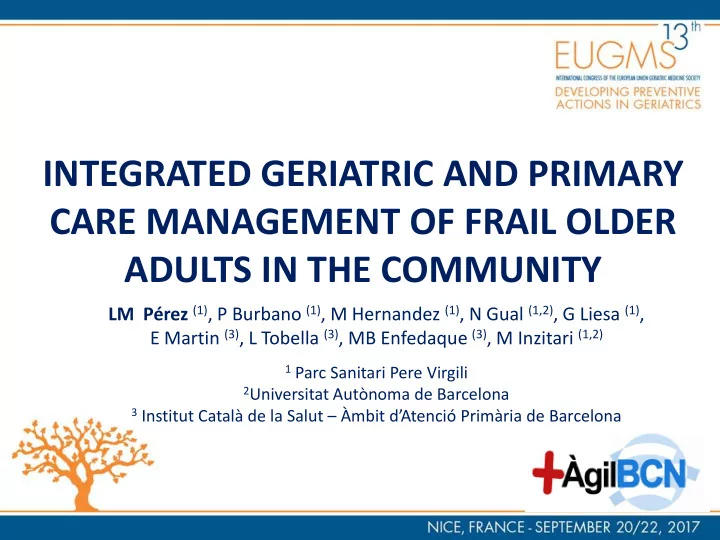

INTEGRATED GERIATRIC AND PRIMARY CARE MANAGEMENT OF FRAIL OLDER ADULTS IN THE COMMUNITY LM Pérez (1) , P Burbano (1) , M Hernandez (1) , N Gual (1,2) , G Liesa (1) , E Martin (3) , L Tobella (3) , MB Enfedaque (3) , M Inzitari (1,2) 1 Parc Sanitari Pere Virgili 2 Universitat Autònoma de Barcelona 3 Institut Català de la Salut – Àmbit d’ Atenció Primària de Barcelona
CONFLICT OF INTEREST DISCLOSURE I have no potential conflict of interest to report
Background (I) Definition Multidimensional clinical entity • Dynamic state of increasing vulnerability • Higher risk of falls, disability, institutionalization and mortality • Determined by: • A decline in physiological reserve and homeostasis • A loss of global functional capacity • A loss of redundancy of systems and pathways • A loss of ability to respond or compensate different types of stressors • Dynamic state Dissability risk
Background (II) Does Frailty, could be reversible? No Frail 754 participants • Independence for ADLs • Follow-up every 18 months • 0.9% 40% 5.8% 11% 20% Frail Pre - Frail 25% Gill MT, et al. Arch Intern Med. 2006 Feb 27;166(4):418-23.
Introduction Geriatrics Community agents Primary Care
Objective To assess the impact on physical performance and frailty, of • an integrated program between geriatrics and primary care, based on frailty screening, comprehensive geriatric assessment and development of tailored intervention.
Methods (I) Geriatric Team Primary Care Team Primary care doctor • Geriatrician • Nurses • Physiotheraphist • Social worker • Patients •
Methods (II) Primary Care Team Geriatric Team • • >80 years old with higher risk Multidisciplinary assessment • • Slowness Comprehensive Geriatric • Memory complaints Assessment • • Involuntary weight loss Geriatrician + PT • • Social risk Specific frailty tools (SPPB, CFS) Tailored intervention plan 3 months follow-up Continuity with existing community resources
Methods (III) Primary Care Team Geriatric Team Tailored intervention plan • Pharmacological interventions • Non-pharmacological interventions • Physical activity program Pharmacological Physical activity program Non-pharmacological • • Review prescriptions • Health education 10 sessions • • Des-prescription • Patient empowerment Strength • Treatment conciliation • • Referral to Dementia Clinics Endurance • Flexibility • Socialization 3 months follow-up Continuity with existing community resources
Results (I) Characteristics N=106 included 81.78 ± 5.07 Age Woman 71.7% (76) 1.5 (1-2) Charlson comorbidity index 24.5% (25) Cognitive impairment CFS vulnerable or frail 61.3% (65) Barthel Index - ADL 95 (85-100) Lawton Index - IADL 6 (3-8) Lives alone 40.57% (43) Self-perceived Health status - Low 28.3% (30) Rockwood et al, CMAJ 2005 Polypharmacy (>5 drugs) 84.91% (90) Physical activity 25.47% (27)
Results (II) Frailty Characteristics Total N=106 Intervention N=106 6.65 ± 2.77 Physical Function (SSPPB) (0-12) Physical activity 93.4% (99) SPPB - Gait speed (m/seg) 0.65 ± 0.19 Health education 97.17% (103) SPPB - Chair stand test (seg) 15.97 ± 10.52 Referral to Dementia Unit 19.8% (20) SPPB- Balance impairment 53.77% (57) Pharmacological changes 64.54% (61.54) Adherence (>7.5 sessions) 80.95% Frailty Characteristics At baseline 3 months Follow-up Improvement p Of finishers (N=51) (N= 51) 6.96 ± 2.23 8.61 ± 2.14 1.65 ± 1.79 <0.001 Physical Function (SSPPB) (0-12) SPPB - Gait speed (m/seg) 0.65 ± 0.25 0.76 ± 0.15 0.11 ± 0.12 <0.001 SPPB - Chair stand test (seg) 16.71 ± 9.70 14.75 ± 6.48 1.95 ± 1.22 0.1157 SPPB- Balance impairment 54.90% (28) 23.52% (12) 16 improve 0.008 Number of drugs 8.12 ± 3.66 8.07 ± 3.5 0.2721 Antipsychotic withdraw 29.41% (15)
Discussion Main limitations • Lack of continuity of “therapeutic exercise” • Lack of psychological support and formal cognitive intervention • Lack of control group Short term plans • Continuity through co-designed exercise program in the community • Assessment of long-term outcomes (adherence to physical activity, hospitalizations, number of drugs) • Evaluation of the implementation process (end-users, professionals)
Conclusions A multidisciplinary and comprehensive geriatric intervention • in frail older community-dwellers could improved physical function. Specific tailored interventions could reversed frailty at 3 • months.
Thanks! Lperez@perevirgili.cat
Recommend
More recommend